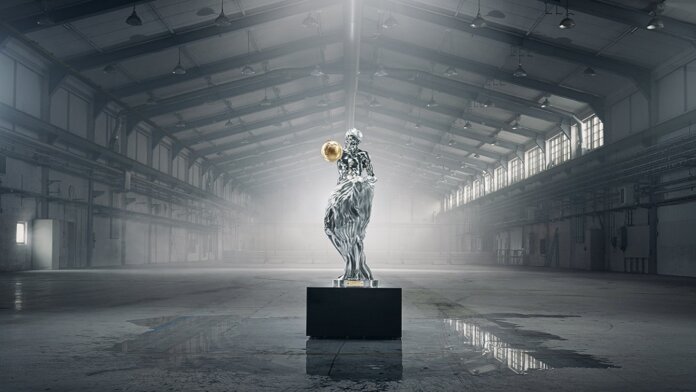There’s been a lot of speculation about the role AI will play in art and creativity. Some think it will give humans a creative boost, while others worry it will detract from our ability to make high-quality art. AI image generation is becoming ubiquitous with programs like DALL-E and Midjourney, and algorithms have been trained to produce artwork in the styles of famous painters. But AI’s most recent artistic foray got even more complex, and it involved a whole new genre: sculpture.
A statue designed by an AI was unveiled last week by Swedish multinational engineering company Sandvik. The Impossible Statue is made of stainless steel, weighs 500 kilograms (1,102 pounds—maybe they meant impossible to move), and stands 5 feet tall. It’s on display at Sweden’s national science and technology museum in Stockholm, Tekniska Museet.
Multiple AIs were involved in designing the statue; they were trained on the work of five famous sculptors, with the output attempting to combine the best-known attributes of each of their unique styles. It incorporates Michelangelo’s “dynamic off-balance poses,” Auguste Rodin’s “musculature and reflectiveness,” Käthe Kollwitz’s “expressionist feeling,” Takamura Kotaro’s “focus on momentum and mass,” and Augusta Savage’s “defiance.”
“Rather than designing an AI system from scratch that went from concept to statue, we decided to use many AI systems so that we could iterate and continuously improve what came out,” said Robert Luciani, a computer scientist at The AI Framework, a consultancy that worked on the project. “The AI can spit out images that are very visually compelling, but that doesn’t mean that they can actually work in real life.”
The AIs created a two-dimensional design based on the work of the five renowned sculptors. Engineers translated the 2D design into a 3D model, then human “pose estimators” refined the body, video game algorithms generated realistic fabric, and another AI added back details that had been lost throughout the preceding steps, resulting in a digital twin of the sculpture.
The team used software and precision cutting tools to hew 17 separate pieces, which were joined to create the finished statue. Thanks to the digital twin, Sandvik reported, testing and verification time were one-sixth what they would have been in a manual operation, and “not a single part of the statue had to be scrapped and remade,” as each component had been digitally refined before the physical fabrication began.
At a glance, the statue could be mistaken for something that belongs in a basketball hall of fame: it depicts a figure with a muscled human torso and arms, one of the arms outstretched holding a ball. A closer look reveals that the ball is a globe. In the statue’s lower half, the torso gives way to a billowing, ruffled form that looks like part of a toga, a leg and foot protruding.
The Impossible Statue is essentially a clever marketing ploy for Sandvik; AI is the talk of the town, and anything it’s involved in is bound to grab some attention. But it’s also yet another example of how the technology can be used in artwork, and of its ability to produce designs that humans wouldn’t dream up on their own.
It’s debatable where the line is between machine and human creativity in scenarios like this; humans chose which artists to train the AIs with, and no doubt picked through many potential designs before settling on this one. If the team had found a talented sculptor and asked him or her to create a unique design based on the styles of the five artists named above, what might the result have been? Would it be better than what algorithms came up with? Does it matter?
We’ll have plenty of opportunities to ponder these questions in the near future, as AI continues to find its niche—or many of them—in different kinds of art.
Image Credit: Sandvik



